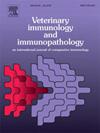Cadmium exposure induced spleen inflammation by activating the MAPK/NF-κB/ NLRP3 signaling pathway and the intervention effect of astilbin
IF 1.4
3区 农林科学
Q4 IMMUNOLOGY
引用次数: 0
Abstract
Cadmium (Cd) is an environmental pollutant with strong immunotoxicity effects. Despite this, the mechanisms by which Cd causes spleen damage in chickens are not well understood. Astilbin (ASB) is a dihydroflavone glycoside with anti-inflammatory and anti-oxidation properties. In the present study, a chicken spleen injury model induced by cadmium exposure (90d) was established to explore the specific mechanisms of Cd-induced spleen injury. If and how ASB ameliorates the damage was also explored. A total of 60 chickens were randomly divided into four groups: Con, Cd, ASB, and Cd+ASB groups. The pathological changes in the spleen were observed by H&E staining. Cd-induced oxidative stress, inflammation, and the involvement of the MAPK/NF-κB/NLRP3 in ameliorating spleen damage were also analyzed by Western blotting, qRT-PCR, and immunohistochemistry. Our results showed that Cd exposure for 90 days damaged the spleen, which mainly manifested as eosinophil infiltration, an increase in MDA content, a decrease in the CAT, GSH, SOD, and T-AOC, and activation of MAPK/NF-κB/NLRP3 signaling pathway. The overall outcome of these events was the induction of oxidative stress and inflammation in the spleen of the chickens. Interestingly, ASB treatment ameliorated Cd-induced damages. In conclusion, the present study revealed the specific mechanism of Cd-induced spleen damage using a chicken model. But ASB ameliorates Cd-induced cadmium poisoning.
镉暴露通过激活MAPK/NF-κB/ NLRP3信号通路及astilbin的干预作用诱导脾脏炎症
镉(Cd)是一种具有很强免疫毒性的环境污染物。尽管如此,Cd引起鸡脾脏损伤的机制尚不清楚。Astilbin (ASB)是一种具有抗炎和抗氧化特性的双氢黄酮苷。本研究通过建立镉暴露(90d)诱导的鸡脾脏损伤模型,探讨镉致脾损伤的具体机制。ASB是否以及如何改善损害也进行了探讨。将60只鸡随机分为4组:Con组、Cd组、ASB组和Cd+ASB组。H&;E染色观察脾脏病理改变。通过Western blotting、qRT-PCR和免疫组织化学分析cd诱导的氧化应激、炎症以及MAPK/NF-κB/NLRP3在改善脾损伤中的作用。结果表明,Cd暴露90 d后,小鼠脾脏出现损伤,主要表现为嗜酸性粒细胞浸润,MDA含量升高,CAT、GSH、SOD、T-AOC水平降低,MAPK/NF-κB/NLRP3信号通路激活。这些事件的总体结果是诱导鸡脾脏氧化应激和炎症。有趣的是,ASB治疗改善了cd引起的损伤。综上所述,本研究通过鸡模型揭示了cd致脾损伤的具体机制。但ASB可改善cd诱发的镉中毒。
本文章由计算机程序翻译,如有差异,请以英文原文为准。
求助全文
约1分钟内获得全文
求助全文
来源期刊
CiteScore
3.40
自引率
5.60%
发文量
79
审稿时长
70 days
期刊介绍:
The journal reports basic, comparative and clinical immunology as they pertain to the animal species designated here: livestock, poultry, and fish species that are major food animals and companion animals such as cats, dogs, horses and camels, and wildlife species that act as reservoirs for food, companion or human infectious diseases, or as models for human disease.
Rodent models of infectious diseases that are of importance in the animal species indicated above,when the disease requires a level of containment that is not readily available for larger animal experimentation (ABSL3), will be considered. Papers on rabbits, lizards, guinea pigs, badgers, armadillos, elephants, antelope, and buffalo will be reviewed if the research advances our fundamental understanding of immunology, or if they act as a reservoir of infectious disease for the primary animal species designated above, or for humans. Manuscripts employing other species will be reviewed if justified as fitting into the categories above.
The following topics are appropriate: biology of cells and mechanisms of the immune system, immunochemistry, immunodeficiencies, immunodiagnosis, immunogenetics, immunopathology, immunology of infectious disease and tumors, immunoprophylaxis including vaccine development and delivery, immunological aspects of pregnancy including passive immunity, autoimmuity, neuroimmunology, and transplanatation immunology. Manuscripts that describe new genes and development of tools such as monoclonal antibodies are also of interest when part of a larger biological study. Studies employing extracts or constituents (plant extracts, feed additives or microbiome) must be sufficiently defined to be reproduced in other laboratories and also provide evidence for possible mechanisms and not simply show an effect on the immune system.

 求助内容:
求助内容: 应助结果提醒方式:
应助结果提醒方式:


